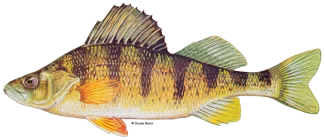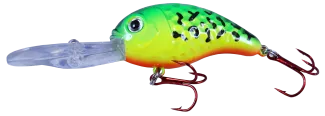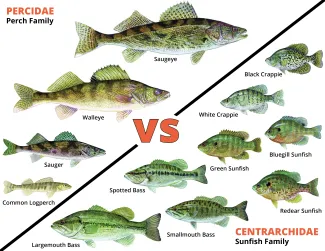IDENTIFICATION
You've maybe heard common Oklahoma sunfish, such as bluegill and redear, referred to as "perch", but did you know that they are not in fact perch? Panfish such as bluegill, black crappie, white crappie and black bass (largemouth, smallmouth and spotted) are actually part of the sunfish family Centrarchidae and have no relation to the perch family Percidae.
Oklahoma does have members of the Percidae family swimming its waters though, but not the species that is most commonly referred to as a perch in North America. That distinction belongs to the yellow perch, a cold water species found in northern states and Canada and favorite prey item of other Percidae species, such as walleye, sauger and saugeye.


The yellow perch is represented in many artificial lure patterns, commonly labeled as Fire Tiger.
The common logperch, a darter fish in the Percidae family, with a maximum length of 7-inches, is also found in some Oklahoma waters, but rarely encountered by anglers.
Members of the perch family have body types that are long and slender, while members of the sunfish family have shorter circular body types. Another big difference is the teeth. Sunfish have rough, sandpaper-esque teeth. Percidae species, such as walleye, sauger and saugeye, have sharp, canine shaped teeth, with cutting ability equivalent to that of a puppy or kitten.

FISHING
The most important factor when fishing for walleye and saugeye is maintaining contact with the bottom. Unlike sunfish species, that spend periods of time at all levels of the water column, walleye and saugeye prefer the bottom third and feed almost exclusively off the bottom.
During the overnight hours and the week of full moons in the spring and fall, walleye and saugeye will congregate in shallow water along rocky, wind-blown shoreline to feed. These are the times when walleye and saugeye are most accessible to bank anglers. Bank anglers also find success below dams when lakes that have walleye and saugeye are discharging water.
Walleye spawn in water 42˚F to 50˚F, which makes them vulnerable to anglers willing to brave the chilly outside temperatures in late February and early March, but the rewards are worth it.
As a general rule of thumb, the spawn typically lasts about three weeks in a given body of water and happens earlier in rivers than in lakes, in shallower lakes than in deeper lakes, in smaller lakes than in larger lakes and in poor water clarity lakes than in clearer lakes.
Walleye spawn over rock, rubble, gravel and similar hard structure in rivers and windswept (north side of water body) lake shores in water 1 to 6 feet deep, where current clears away fine sediment and will cleanse and aerate the eggs.
There will be a lull following the spawn lasting from a few days to a couple weeks depending on the fish and water body. Once the fish recover the post-spawn bite can be more prolific than during the spawning period.
Walleye and saugeye like hard structure transition areas (areas of rapid depth change) near windswept shorelines and points for most of the year. Grassy areas around rocky structure are great spots to target during daylight hours.
They will retreat to deep main lake humps and structure in the summer months as they are a cold-water species most comfortable in water between 50˚F to 70˚F.
Click the button above to view helpful how-to walleye and saugeye fishing videos. Click here for how-to videos from the pros at Northland Fishing Tackle.
Walleye and saugeye like long, slender lipped crankbaits; white, chartreuse, pink/purple or naturally colored grubs; white, chartreuse, pink/purple or naturally colored swimbaits; and an array of live bait (nightcrawlers, leeches and minnows being the most popular).
If using lipped crankbaits, I recommend removing all the treble hooks from the lure and just replace the rear hook with a medium-sized straight shank single point hook. This allows you to bang the crankbait into and across the bottom with a lower percentage of snags or hang-ups.
The slower the retrieve speed the better for any walleye or saugeye presentation.
Crankbaits in fire tiger perch patterns or that have purplish backs are favorites among the toothy fish anglers.
If using natural bait, try a pre-packaged bottom bouncing setup like a Lindy Rig, Pro-Walleye Float'N Harness or make your own using a non-snag weight, barrel swivel, 12- to 24-inch leader and small- to medium-sized bait holding hook paired with natural bait.
FAVORITE LURES/BAITS
- Trolling crankbait: Rapala Shadow Rap in purpledescent tied to a 24" leader line (14lb monofilament) and 1/2 ounce bottom bouncing weight
- Cast and retrieve crankbait: Rapala Shadow Rap Deep in purpledescent when in water less than 10'
- Live bait: Nightcrawler on a 1/4th - 1/2 ounce Lindy Rig
- Jighead: 1/8th - 1/4th ounce Fire-Ball Jig paired with a Sting'R dropper hook and a live minnow or shiner
- Soft plastic: 3 1/2" Z-Man Trick ShotZ in twilight paired with a 1/8th ounce Long Shank Stand-Up Fire-Ball Jig in pink or purple tiger
- Spinner: Pro-Walleye Float'N Harness in fire perch or glo shiner paired with a nightcrawler
- Supplier: Northland Fishing Tackle